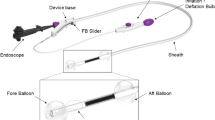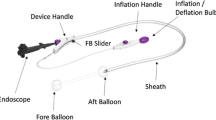Abstract
Introduction
Endoscopic submucosal dissection (ESD) is the ‘gold standard’ for large flat polyps; nevertheless, the rate of adoption in the USA is low. In ESD, the polyp is ‘surgically’ detached with a needle knife after a submucosal lift; gravity and the dissection cap are used for retraction. ESD would be easier if active retraction were possible. In an ex vivo bovine colon model, this study assessed an overtube system (Boston Scientific ORISE Tissue Retraction System, TRS) that permits retraction and creates ‘an operative field’ for removal of rectal/sigmoid lesions.
Method
Classic ESD (C-ESD) was compared to TRS-facilitated ESD (TRS-ESD). Cleaned/preserved bovine large bowel was used, and two 2-cm ‘lesions’/colon were branded onto the mucosal surface 25 and 35 cm from the anus. Submucosal saline lifts were made using a thin catheter and a standard needle knife. We tracked case length, number of instrument exchanges (to refresh lift), the volume of lift solution, the fullness of resection, and deep muscle injuries.
Results
Fifty ESDs were carried out in 25 colons (25 C-ESD, 25 TRS-ESD). Complete resections were noted in all cases. The TRS method required fewer instrument exchanges (median 5) vs C-ESD (median 9, p < 0.0001) and less lift solution (median 39 ml) than the C-ESD cases (median 55 ml, p = 0.0003). TRS-ESD was associated with fewer deep muscle injuries (median 2) than C-ESD (median 3, p = 0.0191). Finally, the TRS group’s median case length (34.5 min) was shorter than that of C-ESD (41 min, p = 0.0543).
Conclusion
The TRS system provides retraction and facilitates ESD regarding the number of lift injections, the volume of lift solution needed, and avoidance of muscle injuries. Of note, there is an apparent TRS learning curve, and the device mandates a distal-to-proximal approach and initial 360 degree mucosal incision. Further study is warranted.














Similar content being viewed by others
References
Akintoye E, Kumar N, Aihara H, Nas H, Thompson CC (2016) Colorectal endoscopic submucosal dissection: a systematic review and meta-analysis. Endosc Int Open 4:E1030–E1044
Kaltenbach T, Anderson JC, Burke CA, Dominitz JA, Gupta S, Lieberman D, Robertson DJ, Shaukat A, Syngal S, Rex DK (2020) Endoscopic removal of colorectal lesions-recommendations by the us multi-society task force on colorectal cancer. Gastrointest Endosc 91:486–519
Gotoda T, Kaltenbach T, Soetikno R (2008) Is en bloc resection essential for endoscopic resection of GI neoplasia? Gastrointest Endosc 67:805–807
Oka S, Tanaka S, Kaneko I, Mouri R, Hirata M, Kawamura T, Yoshihara M, Chayama K (2006) Advantage of endoscopic submucosal dissection compared with EMR for early gastric cancer. Gastrointest Endosc 64:877–883
Rex DK, Hassan C, Dewitt JM (2017) Colorectal endoscopic submucosal dissection in the United States: why do we hear so much about it and do so little of it? Gastrointest Endosc 85:554–558
Friedel D, Stavropoulos SN (2018) Introduction of endoscopic submucosal dissection in the West. World J Gastrointest Endosc 10:225–238
Peery AF, Cools KS, Strassle PD, McGill SK, Crockett SD, Barker A, Koruda M, Grimm IS (2018) Increasing rates of surgery for patients with nonmalignant colorectal polyps in the United States. Gastroenterology 154:1352–1360
Lim SG (2020) The development of robotic flexible endoscopic platforms. Int J Gastrointestinal Intervention 9:4
Jung YS, Park D Il (2013) Submucosal injection solutions for endoscopic mucosal resection and endoscopic submucosal dissection of gastrointestinal neoplasms. Gastrointestinal Intervention 2:5
Tsuji K, Yoshida N, Nakanishi H, Takemura K, Yamada S, Doyama H (2016) Recent traction methods for endoscopic submucosal dissection. World J Gastroenterol 22:5917–5926
Imaeda H, Hosoe N, Kashiwagi K, Ohmori T, Yahagi N, Kanai T, Ogata H (2014) Advanced endoscopic submucosal dissection with traction. World J Gastrointest Endosc 6:286–295
Dahan M, Pauliat E, Liva-Yonnet S, Brischoux S, Legros R, Tailleur A, Carrier P, Charissoux A, Valgueblasse V, Loustaud-Ratti V, Taibi A, Durand-Fontanier S, Valleix D, Sautereau D, Kerever S, Jacques J (2019) What is the cost of endoscopic submucosal dissection (ESD)? A medico-economic study. United European Gastroenterol J 7:138–145
Committee AT, Maple JT, Abu Dayyeh BK, Chauhan SS, Hwang JH, Komanduri S, Manfredi M, Konda V, Murad FM, Siddiqui UD, Banerjee S (2015) Endoscopic submucosal dissection. Gastrointest Endosc 81:1311–1325
Author information
Authors and Affiliations
Corresponding author
Ethics declarations
Disclosures
This is an investigator-initiated study sponsored by Boston Scientific Corporation (BSC). BSC provided the colonoscopic devices ORISE™ Tissue Retractor Systems and associated accessories without charge. Financial support was also provided for this study via a contract between Northwell Health and BSC (BSI research Grant # ISREND00060). Dr. Richard L. Whelan received a second BSC research grant (# ISREND00084) for an unrelated investigator initiated and contracted study. Drs. Xiaohong Yan, Neil Mitra, Dasuni Niyagama Gamage, Abhinit Shah, HMC Shantha Kumara, and Vesna Cekic have no conflicts of interest or financial ties to disclose.
Additional information
Publisher's Note
Springer Nature remains neutral with regard to jurisdictional claims in published maps and institutional affiliations.
Rights and permissions
About this article
Cite this article
Yan, X., Mitra, N., Gamage, D.N. et al. A colonoscopic overtube system that creates a ‘therapeutic zone’ and permits retraction facilitates endoscopic submucosal dissection, was associated with fewer deep bowel wall injuries and instrument exchanges, and required less lifting solution vs classic endoscopic submucosal dissection in an ex vivo bovine model. Surg Endosc 36, 5897–5906 (2022). https://doi.org/10.1007/s00464-022-09203-z
Received:
Accepted:
Published:
Issue Date:
DOI: https://doi.org/10.1007/s00464-022-09203-z




